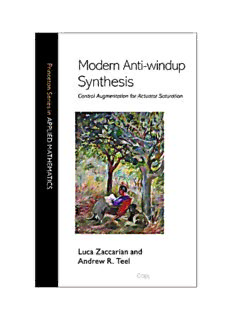
Modern Anti-windup Synthesis: Control Augmentation for Actuator Saturation PDF
Preview Modern Anti-windup Synthesis: Control Augmentation for Actuator Saturation
Modern Anti-windup Synthesis PrincetonSeriesinAppliedMathematics SeriesEditors:IngridDaubechies(PrincetonUniversity);WeinanE(PrincetonUniversity); JanKarelLenstra(EindhovenUniversity);EndreSüli(UniversityofOxford) The Princeton Series in Applied Mathematics publishes high quality advanced texts and monographsinallareasofappliedmathematics. Booksincludethoseofatheoreticaland generalnatureaswellasthosedealingwiththemathematicsofspecificapplicationsareas andreal-worldsituations. Chaotic Transitions in Deterministic and Stochastic Dynamical Systems: Applications of MelnikovProcessesinEngineering,Physics,andNeuroscience,EmilSimiu SelfsimilarProcesses,PaulEmbrechtsandMakotoMaejima Self-Regularity: ANewParadigmforPrimal-DualInteriorPointAlgorithms,JimingPeng, CornelisRoos,andTamasTerlaky AnalyticTheoryofGlobalBifurcation:AnIntroduction,BorisBuffoniandJohnToland Entropy,AndreasGreven,GerhardKeller,andGeraldWarnecke,editors AuxiliarySignalDesignforFailureDetection,StephenL.CampbellandRamineNikoukhah Thermodynamics:ADynamicalSystemsApproach,WassimM.Haddad,VijaySekhar Chellaboina,andSergeyG.Nersesov Optimization:InsightsandApplications,JanBrinkhuisandVladimirTikhomirov MaxPlusatWork,ModelingandAnalysisofSynchronizedSystems:ACourseonMax-Plus AlgebraandItsApplications,BerndHeidergott,GeertJanOlsder,andJacobvanderWoude ImpulsiveandHybridDynamicalSystemsStability,Dissipativity,andControl,WassimM. Haddad,VijaySekharChellaboina,andSergeyG.Nersesov TheTravelingSalesmanProblem: AComputationalStudy,DavidL.Applegate,RobertE. Bixby,VasekChvatal,andWilliamJ.Cook PositiveDefiniteMatrices,RajendraBhatia GenomicSignalProcessing,IlyaShmulevichandEdwardDougherty WaveScatteringbyTime-DependentPerturbations:AnIntroduction,G.F.Roach AlgebraicCurvesoveraFiniteField,J.W.P.Hirschfeld,G.Korchmáros,andF.Torres DistributedControlofRoboticNetworks: AMathematicalApproachtoMotionCoordina- tionAlgorithms,FrancescoBullo,JorgeCortés,andSoniaMartínez RobustOptimization,AharonBen-Tal,LaurentElGhaoui,andArkadiNemirovski ControlTheoreticSplines:OptimalControl,Statistics,andPathPlanning,Magnus EgerstedtandClydeMartin Matrices,Moments,andQuadraturewithApplications,GeneGolubandGérardMeurant TotallyNonegativeMatrices,ShaunM.FallatandCharlesR.Johnson MatrixCompletions,Moments,andSumsofHermitianSquares,MihályBakonyiandHugo J.Woerdeman ModernAnti-windupSynthesis:ControlAugmentationforActuatorSaturation,Luca ZaccarianandAndrewR.Teel Modern Anti-windup Synthesis Control Augmentation for A tuator Saturation Lu a Za arian and Andrew R. Teel PRINCETON UNIVERSITY PRESS PRINCETON AND OXFORD Copyright c 2011byPrincetonUniversityPress (cid:13) PublishedbyPrincetonUniversityPress,41WilliamStreet,Princeton,NewJersey 08540 IntheUnitedKingdom: PrincetonUniversityPress,6OxfordStreet,Woodstock, OxfordshireOX201TW press.princeton.edu Coverart: FioreB.Zaccarian,Letturasottoglialberi(readingunderthetrees),oil oncanvas,1970. CourtesyofDr. PaoloZaccarian. AllRightsReserved LibraryofCongressCataloging-in-PublicationData Zaccarian,Luca. Modern anti-windup synthesis: control augmentation for actuator saturation / LucaZaccarian,AndrewR.Teel. p. cm. –(Princetonseriesinappliedmathematics) Includesbibliographicalreferencesandindex. ISBN978-0-691-14732-1(hardback) 1. Automaticcontrol–Mathematicalmodels. 2. Linearcontrolsystems. 3. Actuators. I.Teel,AndrewR.,1965-II.Title. TJ213.7.Z3262011 629.8’3–dc22 2010044248 BritishLibraryCataloging-in-PublicationDataisavailable Thepublisherwouldliketoacknowledgetheauthorsofthisvolumeforproviding thecamera-readycopyfromwhichthisbookwasprinted. Printedonacid-freepaper. ∞ PrintedintheUnitedStatesofAmerica 10987654321 Contents Prefa e ix Algorithms Summary xi PART 1. PREPARATION 1 1. The Windup Phenomenon and Anti-windup Illustrated 3 1.1 Introduction 3 1.2 Illustrativeexamples 4 1.3 Summary 21 1.4 Notesandreferences 22 2. Anti-windup: De(cid:28)nitions, Obje tives, and Ar hite tures 23 2.1 Preliminaries 23 2.2 Qualitativeobjectives 26 2.3 Anti-windupaugmentation 32 2.4 Quantitativeperformanceobjectives 40 2.5 Notesandreferences 47 3. AnalysisandSynthesisofFeedba kSystems: Quadrati Fun tionsandLMIs 48 3.1 Introduction 48 3.2 Unconstrainedfeedbacksystems 50 3.3 Linearmatrixinequalities 51 3.4 Constrainedfeedbacksystems:globalanalysis 59 3.5 Constrainedfeedbacksystems:regionalanalysis 63 3.6 Analysisexamples 67 3.7 Regionalsynthesisforexternalstability 70 3.8 Notesandreferences 73 PART 2. DIRECT LINEAR ANTI-WINDUP AUGMENTATION 75 4. Stati Linear Anti-windup Augmentation 77 4.1 Overview 77 4.2 Keystate-spacerepresentations 78 4.3 Algorithmsprovidingglobalguarantees 81 4.4 Algorithmsprovidingregionalguarantees 98 4.5 Notesandreferences 107 vi CONTENTS 5. Dynami Linear Anti-windup Augmentation 109 5.1 Overview 109 5.2 Keystate-spacerepresentations 110 5.3 Factoringrank-deficientmatrices 113 5.4 Algorithmsprovidingglobalguarantees 114 5.5 Algorithmsprovidingregionalguarantees 141 5.6 Notesandreferences 152 PART 3. MODEL RECOVERY ANTI-WINDUP AUGMENTATION 155 6. The MRAW Framework 157 6.1 Introduction 157 6.2 Ablockdiagram/transferfunctiondescription 158 6.3 Astate-spacedescription(linearitynotneeded) 161 6.4 Robust,fragile,orboth? 164 6.5 Notesandreferences 167 7. Linear MRAW Synthesis 174 7.1 Introduction 174 7.2 Globalstability-basedalgorithms 176 7.3 Regionalstabilityandperformancealgorithms 195 7.4 Notesandreferences 199 8. Nonlinear MRAW Synthesis 200 8.1 Introduction 200 8.2 Switchingandschedulinglinearcontrollers 201 8.3 Modelpredictivecontrolforanti-windupdesign 208 8.4 Globaldesignsfornon-exponentiallyunstableplants 217 8.5 Designsforexponentiallyunstableplantsthatmaximizethebasinofattraction 222 8.6 Notesandreferences 225 9. The MRAW Stru ture Applied to Other Problems 226 9.1 Rate-andmagnitude-saturatedplants 226 9.2 Anti-windupfordead-timeplants 232 9.3 Bumplesstransferinmulticontrollerschemes 235 9.4 Reliablecontrolviahardwareredundancy 240 9.5 Notesandreferences 243 10.Anti-windup for Euler-Lagrange Plants 245 10.1 FullyactuatedEuler-Lagrangeplants 245 10.2 Anti-windupconstructionandselectionofthestabilizerv 246 10.3 Simulationexamples 250 10.4 Notesandreferences 268 11.Annotated Bibliography 269 11.1 Overview 269 11.2 Problemdiscovery 269 11.3 Thefirstconstructivetechniques 270 CONTENTS vii 11.4 Callforsystematization 271 11.5 Modernanti-windupschemes 272 11.6 Additionalreferences 281 Index 285 This page intentionally left blank Prefa e When feedback control is synthesized for a linear plant, an often neglected but importantfeatureofthefeedbackloopisasaturationnonlinearityattheplantinput. A saturated input typically provides a better model of reality than a linear input modeldoes. Indeed,allrealactuatorshavelimitedcapabilitiesandtheselimitscan haveadramaticeffectontheperformanceofanotherwiselinearfeedbackloop. In the face of input saturation, the control engineer must accept that the achievable largesignalperformanceisinherentlylimited. Thenheorshemustdecidehowto addressthisfactincontrolsynthesis. When input saturation is expected to be a common occurrence in the plant’s operation, it makes sensetolook for designmethodologies thataccountfor input saturationdirectly.Therearemanyusefultechniquesinthiscategorythathavebeen developed in the control literature, including the very popular “model predictive control” framework. In the case where input saturation is expected to be a less frequentoccurrenceandthesmallsignalperformancespecificationsaredifficultto incorporateintoageneralframeworklikemodelpredictivecontrol,itmakessense toconsiderthe“anti-windup”paradigm. In the anti-windup synthesis problem, a controller for the saturation-free case hasalreadybeensynthesizedbasedonsomeperformancecriterionandithasbeen confirmedthatthiscontrollerdoesnotperformwellwheninputsaturationoccurs. In this case, the task is to synthesize a controller augmentation that has no effect whensaturationdoesnotoccurandthatotherwiseattemptstoprovidesatisfactory performance for large signals. In this way, the small signal performance is not compromisedforthesakeofguaranteeingacceptablelargesignalperformance. This book is dedicated to the description of anti-windup synthesis algorithms. Thefocusisonstate-spacemethodsandsynthesisalgorithmsthatrequiresolving linearmatrixinequalities(LMIs). Manyefficientsoftwareprograms,suchasMAT- LAB/Simulink,1arewidelyavailableforsolvingtheseLMIs.Inordertofollowthe material in this book, the reader should be familiar with state-space descriptions andbasicstabilitytheoryforlinear, continuous-timesystems. Inordertobecome comfortablewiththealgorithmsandtheirbehaviors,thereadershouldbewillingto investtheenergyrequiredtogaincompetencywithanLMIsolver. Severalexam- plesareprovidedinthetextthatcanbeusedbythereadertotesttheunderstanding 1MATLAB(cid:13)R andSimulink(cid:13)R areregisteredtrademarksofTheMathWorksInc. andareusedwith permission. TheMathWorksdoesnotwarranttheaccuracyofthetextorexercisesinthisbook. This book’suseofMATLAB(cid:13)R andSimulink(cid:13)R doesnotconstituteanendorsementorsponsorshipbyThe MathWorksofaparticularpedagogicalapproachorparticularuseoftheMATLAB(cid:13)R andSimulink(cid:13)R software.
Description: